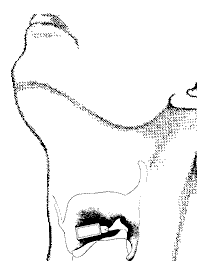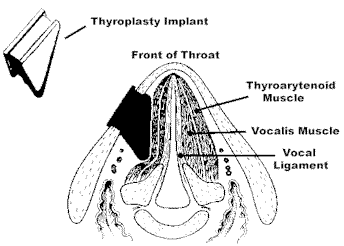The Montgomery Thyroplasty Implant
![]()
The Montgomery thyroplasty implant has been designed to treat the disabilities associated with unilateral vocal cord paralysis: absent or impaired voice, aspiration and ineffective cough. |
| What began as an idea carved out of a block of maple wood has
evolved into a new prosthetic device for the treatment of unilateral (one-sided) vocal
cord paralysis. What Does the Implant Do? This prosthesis, invented by Dr. Montgomery, is the result of three years of research and five years of clinical application. Known as the Montgomery Thyroplasty Implant, this device corrects the disabilities associated with unilateral vocal cord paralysis: absent or impaired voice, aspiration and ineffective cough. |
 |
| How Does It Work? | |
| The result of paralysis of one of the two vocal cords can be quite devastating. Three things happen. The voice is reduced to dysphonia (loss of voice or hoarseness). The patient aspirates when swallowing due to the inability of the vocal cords to close and protect the trachea and lungs. This is especially true of liquids. Fear of choking when swallowing becomes intensified and as a result the patient develops a fear of swallowing and is not properly nourished. Often a weight loss accompanies one-sided vocal cord paralysis. The third symptom associated with unilateral vocal cord paralysis is an ineffective cough. In order to produce an effective cough, we must first close our vocal cords and build up pressure in the chest. The pressure is released when the vocal cords snap open. This is not possible when one vocal cord is paralyzed. Having an ineffective cough, the patient is unable to clear secretions from the lungs. This combination of aspiration and ineffective cough often leads to pneumonia. | |
 |
The thyroplasty implant is a one-piece plastic prosthesis which is inserted by way of an incision made in a natural fold of the neck. Once inserted, the implant pushes the paralyzed vocal cord to the midline so that the opposite functioning cord can contact it to phonate and close the airway when needed to prevent aspiration and produce an effective cough. The implant is made from a medical-grade polymer material which, once implanted, remains firmly in place. It is easily removed if vocal cord function returns or if a change of size is indicated. Five sizes are available for the male larynx and five sizes for the female larynx. The correct size for the implant is determined with special instruments at the time of surgery. No sutures are needed and scarring is minimal. The patient is able to leave the hospital after an overnight stay. |
For further information, please contact Dr. Montgomery (1-617-573-3669), or Boston Medical Products 117 Flanders Road, Westborough MA 01581 (1-800-433-2674).